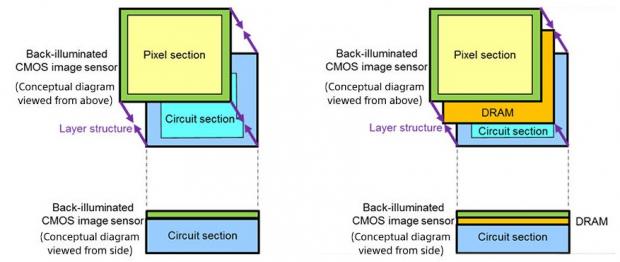Sony's new CMOS image sensor for smartphones is the first to feature 3-layer stacked configuration with DRAM for improved speed and lower power consumption. The new sensor packs 21.2 effective megapixels and can easily record 4K video at 60 fps or full HD (1080p) at 240 fps.
The Japanese company says the sensor's DRAM capacity is 1 Gigabit (125 MB) and that it can read one still image of 19.3 million pixels in only 1/120 second, which is four times faster than conventional products. Moreover, the sensor supports shooting of super slow motion movies with a maximum frame rate of 1,000 fps in full HD (1080p).
The CMOS image sensor is only 1.22μm in size and is said to include solutions for multiple technical issues inherent in the design, such as reducing noise generated between the circuits on each of the three layers.
According to Sony, the technology implemented in its new image sensor “minimizes the focal plane distortion in still images that tends to occur when shooting fast-moving subjects on smartphones, which lack a mechanical shutter for controlling exposure time.”

Furthermore, the company explains that in order for the image sensor to achieve the high-speed readout, it used a double circuit from a 2-tier construction to a 4-tier construction to convert the analog video signal from pixels to a digital signal, which will also result in improved software processing.
The DRAM packed on the images sensor is specifically used to store signals read at high speed temporarily, which should enable data to be output at an optimal speed for the standard specifications.
As mentioned earlier, the addition of DRAM enables the new CMOS image sensor to attain impressive reading speeds for still images: 19.3 million pixels in only 1/120 of a second.
Unfortunately, Sony does not mention when its new CMOS image sensor with dedicated DRAM will be commercially available, but there's a high chance they will be first included on Xperia smartphones.

 14 DAY TRIAL //
14 DAY TRIAL // 
